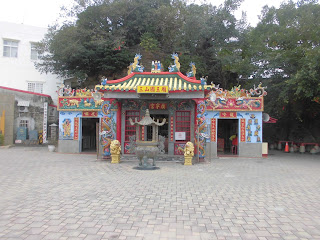前回は南門を見た、今回は西門を。この門の場合は日本統治時代に塔が取り除かれた。でも最近歩道が整備されて、上に乗って周りの街並みを見ることができる。
We checked out Hungchwun's South Gate in the previous post, so now it's time to go and see the West Gate. This gate lacks a tower--it was torn down during the Japanese period--but the base structure remains, and pedestrian walkways have been added to it in more recent years so that you can go up on top.
上次看南門。這次要看西門。很可惜西門門樓日治時代已經被拆除了。但因為現在上面有行人路的設備,所以你可以爬上看看。
道路が下を通っている。向こうから来る車に気をつけて!
A road passes right through. Be careful of oncoming traffic!
小心對面的車子!
This is a copy of the tablet mentioned in the plaque in the first photo. This is how they used to promulgate laws in Ching Dynasty Manchuria.
在上面第一張照片裡寫這個石牌的事情。清治時代用石牌來公佈法律!
我們上去看好吧。
上に登ってみたら向こうの山がよく見える。
Let's go on top! You can see mountains in the distance. Hungchwun is mostly surrounded by mountains.
看到了遠方的山地。
ここに市塀が絶えて道路が通過している。これはおそらく日本時代の出来事であろう。日本政府は台湾の交通の現代化に力を入れて、より広い道路を整備する為にたくさんの市塀や、細い道などを壊した。
You can see where the city walls continue on the other side of the road. This section was probably knocked down by the Japanese. They destroyed a lot of city walls in Taiwan when they took over because they were primarily interested in modernizing the island and improving its economy, and this included building a more efficient road system. Sometimes old structures were in the way of the new roads.
這面牆應該是日治時代拔除的。當時日本政府決定要把台灣的交通改好了,很多大門啊,牆啊都被破壞了。
門の上に立ち、広場の向こうの廟を見ている。
Here I am on top of the gate itself, with the road running below me. There's an open space with a temple at the far corner.
我剛好站在門上,我下面有那條馬路。看得到一座廟在空地對面。
歴史遺物を気にかけずに通過するバイク
People speeding through their infrastructural history.
沒在乎周邊的歷史遺物就飆過去的觀光客。
白い四角は多分以前の塔の柱があった場所であろう。沖縄の勝連城を思い出す。
I assume the squares on the floor here are where the former tower's support columns were originally.
這些白白的四角形應該以前是門樓的柱子吧。
塀の隣りの家。以前の台所(?)が外側になって変な感じがする。
A home right next to the wall. It looks like there used to be a bathroom or kitchen here. Now three of the walls have been knocked down and the remaining tile wall is bizarrely exposed to the outside world.
牆旁的房子。好像以前這裡是廚房。因為現在變成外面了所以感覺起來奇怪。
塀の隣りに広い公園がある。
There's a large park next to the wall.
牆旁邊有寬寬的公園。
公園内にこの石碑があった。階段があるので、かなり重要な歴史的な遺物に見えるが、周りに全く案内する様な看板はなかった!何のこと?文字は不思議なことに削られている様に見える。日本時代の石碑かなと思った。それなら戦後の反日の運動の時に削られたかもしれない。でも全く分からない。
I walked around in the park and came upon this stone tablet. I couldn't find any explanation for it nearby, even in Chinese. It's important enough that they built stairs going up to it, but the letters also appear to have been scratched out. I wondered if maybe it was a Japanese-era tablet that had been deliberately defaced during the post-WWII era. I really have no idea though.
公園裡我碰到這個石牌。因為有樓梯,所以看起來是重要的歷史遺物。但是周邊都沒有找到什麼解釋的看板。我不知道這是什麼,也不知道為何字看起來有擦掉了。我猜可能是日治時代的石牌,戰後被擦掉了,但是我不確定。
下にももう一個あった。
Another tablet below, also with letters that appear to have been scratched out.
下面有另外一個。它的字也看不清楚。
看起來是中文,,,
こっちも読めない。でも本当に日本語かな?私の推測が間違っているかもしれない。中国語に見えるが、、、
町の地図。
A map of town, with historic buildings and complete walls.
全城市的地圖
丘の上の石碑
Here's the tablet and the little hill it's on from a distance.
石牌在丘上。
公園の裏側に廃棄された建物がたくさんあった。なんとなく軍基地っぽいと思った。もしかしてここに基地があったかもしれない。他に思いついたのは中国から渡ってきた軍人の村だったかもしれない。中国の内戦によって中華民国政府が共産党を逃げて台湾に移動してきた時、たくさんの兵士も一緒に渡ってきた。この人たちは台湾と全く縁がなくて、自分達の隔離された村を作って生活した例が多い。台湾を逃げた日本人から受け継がれた村もあるが、戦後時代に急いで建てた村もある。どちらにしても家が古いし、街から隔離された感じのものが多いので、子孫が住みたくないことは多い。そのため、こういう「眷村」に住民がだんだんいなくなっている状態のところが数多い。眷村の中には元々違法建築だったものもある。政府はずっとそれを無視してきたが、もし金持ちの投資家が現れてきて土地に何か建てたいと言い出したら、政府は急に違法建築のことを言い訳にして住民を追い出す例もある。
Behind the park were a bunch of abandoned buildings. The architectural style made me think that maybe they were former dorms for soldiers, or perhaps it was a settlement for former soldiers. There are lots of settlements all over Taiwan like that. Soldiers who came over from China after WWII were cut off from their homelands (thanks to the Chinese Civil War) and on an island where they didn't know anyone. They often ended up living in communities all by themselves, separated from the rest of Taiwanese society. Some of these communities were made of buildings abandoned by the Japanese, some were made of buildings hastily put up in the post-war years. Either way, these communities have in many cases disappeared, or are in the process of disappearing, because the old residents are dying, and their descendants don't usually want to live in the old houses in these cut off communities. (There also have been cases where the government turned around and suddenly declared that a settlement of old soldiers was an illegal settlement. Despite having ignored these illegal settlements for decades, developer money has a strange way of making the government care about whether or not structures have been built illegally.)
公園後面有一些房子。都是空空的。我不確定可是我認為看起來據點的建築。以前這裡有句點嗎?還是我也猜有可能是一個眷村。台灣有很多變空了的眷村。
鶏おった。
A chicken!?
雞出現!
門上から見た廟。
The temple we saw from on top of the city wall before.
站在門上看到的那座廟。
古い家がかなり残っている。
Some nearby old buildings.
對面的房子。
また次回ね!
To be continued...
下次繼續







































No comments:
Post a Comment